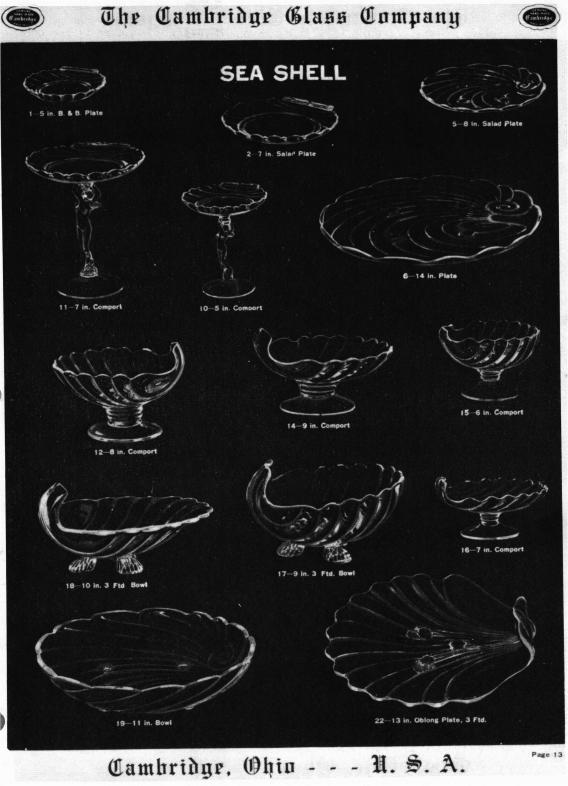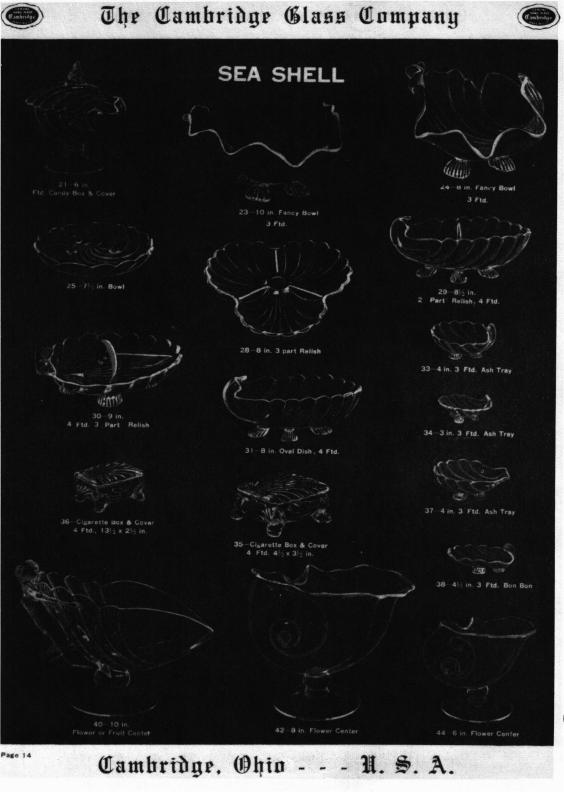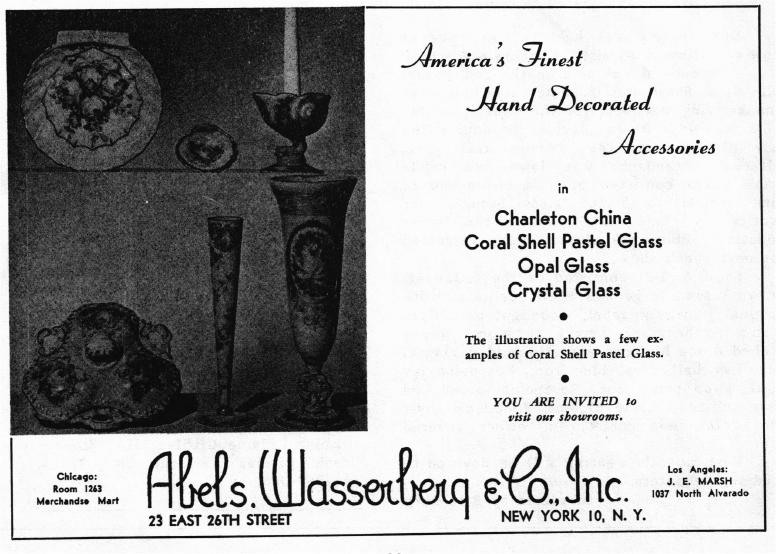Crown Tuscan, Part II
by Mark A. Nye
Issue No. 155 - March 1986
Note: Pictures to accompany this article are found at the end of the article.
In the introduction to the January 1, 1940 Cambridge price list, Crown Tuscan and Coral are both described as "Opaque Shell Pink." However, as previously mentioned, these two color names were not used interchangeably. Coral was used only in conjunction with the Sea Shell line while Crown Tuscan was used elsewhere.
In 1940, the Sea Shell line was made up of 31 items. These included, from the Statuesque or Nude line, the 9" candlestick, the 9" candelabrum (which is the 9" candlestick with bobeche and prisms), the 5" and 7" comports, and the 10" flower or fruit center - the #3011/40 often referred to as the "Flying Lady" bowl.
There is a discrepancy between the January 1, 1940 Cambridge catalog and it's price list regarding this color. The catalog pictures the #647 6", 2-holder candlestick (keyhole) in Coral and does not show the dinner or fish plate, Sea Shell #3, listed as being 9", while the price list includes the dinner and not the candleholder.
Prices, at the time, ranged from $3.75 per dozen for the #34 ash tray to $60 per dozen for the #40 10" flower center and $70 per dozen for the #61 9" candelabrum.
Use of the Coral name continued on into the late 1940s. It was sometime between January 1947 and June 1949 when the name Coral disappeared from the Cambridge line.
Use, in 1940, of the Crown Tuscan name was limited to 23 undecorated items and 22 pieces available with any of four gold encrusted etchings: Portia, Diane, Rose Point and Candlelight. The undecorated ware included the #647 candleholder and two items from the Nude line, the 9" candlestick and candelabrum. This is one of the rare cases where the same piece is listed in both Coral and Crown Tuscan and should not be taken as evidence that the names represent unique colors. Fifteen of the Crown Tuscan items offered in the 1940 catalog were vases. Also being made in Crown Tuscan as the 1940s began was the #1040 3" swan and it was retailing at $5 per dozen. The only difference between the listings for decorated and undecorated items was the absence of the swan from the decorated listing.
Prices for the decorated ware most certainly reflected the labor involved in the decorating process and the cost of materials. The #3500/42 covered urn sold for $45 per dozen ($3.75 each) undecorated, while after being etched and gold encrusted, it sold for $12.50 each or $150 per dozen. In comparison, the same urn with cover sold for $33.75 per dozen in plain crystal, $52.50 per dozen crystal etched Rose Point and $135 per dozen for crystal etched Rose Point and gold encrusted.
While most certainly there must have been additional price lists or price list supplements issued by Cambridge during the mid-to-late 1940s, none have yet surfaced or become available to researchers. Our next known Cambridge documents showing availability of Crown Tuscan are the June 1949 catalog and price list.
Under the heading "Crown Tuscan" in the June 1949 price list were nine items from the Sea Shell line along with 16 pieces from other lines. Still being made were the "Flying Lady" bowl and the 9" Nude Candlestick. There was now an 8½" Crown Tuscan swan, the #1043; and three vases that did not appear on the 1940 list, the #1236, #1237 and #1238.
Gold decorated Crown Tuscan remained in the Cambridge line as the 1940s were ending. Twelve items, including seven vases and the 9" Nude candlestick, were available with the same four gold encrusted etchings used in 1940: Diane, Portia, Rose Point and Candlelight. In addition, eight pieces from the Sea Shell line were being made with D/1018 (Gold stippled Edge) as was the 9" Nude candlestick, the #1040 and #1043 swans and the #3500/57 3-part candy box and cover.
A new price list was issued in September 1950 and once again Crown Tuscan was listed. Items included in this price list were all of those from 1949 plus the Sea Shell #66 candlestick and the Mt. Vernon #102 2-handled miniature urn. In addition to these items, under the heading of "Colored Glassware Miscellaneous" was the #3011 Nude line 3 oz. #9 cocktail with Gold Krystol bowl and Crown Tuscan stem and foot.
All of the gold decorated Crown Tuscan ware from the 1949 price list remained in the line and added to it were the Sea Shell #66 and the #3900/575 10" cornucopia, both with D/1018.
The last Cambridge price list issued before the initial plant closing in 1954, dated October 1953, failed to include any mention of Crown Tuscan. Thus, it would appear that sometime between the fall of 1950 and the fall of 1953, a decision was made to eliminate Crown Tuscan from the Cambridge line.
Trade references to Coral, Crown Tuscan and "Charleton" decorations published during the 1940s and early 1950s included the following items:
"Lovely bud vase and candy box from the 'Charleton' china line at Abels, Wasserberg & Co. Inc." (Crockery & Glass Journal, September 1945). (Author's note: Shown with this caption were the #274 bud vase and the #3500/57 covered candy.)
"Their (Cambridge) popular coral colored decorative pieces now come all dressed up with a gold stippled border. This line, including candlesticks, bowls, compotes, cigarette boxes ..." (China, Glass & Decorative Accessories, August 1949).
"The popular 'Crown Tuscan' cocktail glasses with the graceful coral figure holding the mandarin gold bowl are now back again to retail at $1.50 apiece." (China, Glass & Decorative Accessories, December 1949).
"'Charleton' presents the ultimate in glass accessories Coral Shell enhanced by a new hand painted pattern Blue Mist." (Crockery & Glass Journal, May 1952) (Author's note: Shown with this caption were the 5" and 7" shell plates, the #35 or #36 cigarette box, a swan, and other items.)
The reader, and especially so the inexperienced Cambridge collector, is cautioned that other companies, in addition to Cambridge, made pink opaque glass. These include; Fenton, Fostoria, Jeannette, Westmoreland, and the Aladdin Lamp Company.
The experienced Cambridge collector will have no difficulty in recognizing Coral or Crown Tuscan pieces, but the beginning collector form time to time may be confused. The only answer is to learn the Cambridge line and whenever the opportunity arises to examine and study a piece of Cambridge Crown Tuscan ... take advantage of it.



